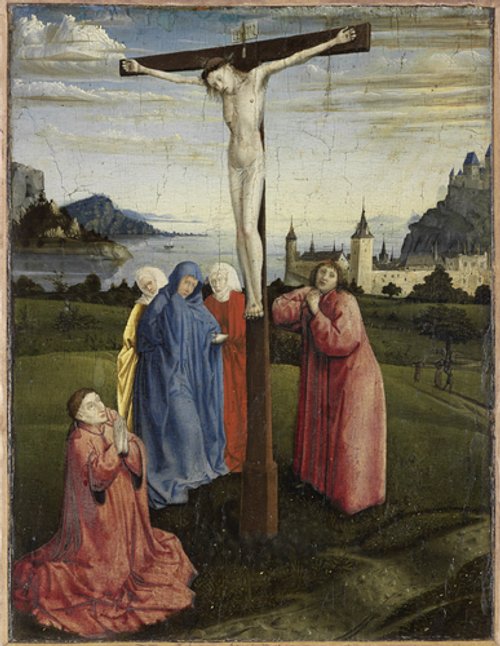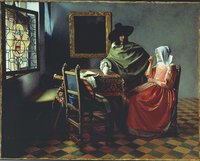Auf den ersten Blick erscheint das kleine Gemälde wie eine gewöhnliche Kreuzigungsdarstellung, die allerdings in eine wunderbar erfasste nordalpine Landschaft versetzt ist. Doch irritiert dabei die Position des Stifters, der im Gebet genau vor Christus kniet, während die biblischen Gestalten, Maria mit zwei heiligen Frauen und Johannes, merkwürdigerweise hinter dem Kreuz platziert sind. Aufschluss ergibt die Betrachtung des Kreuzes selbst, das mit seinem profilierten Sockel offenbar nicht als das historische Leidensgerät auf Golgatha zu verstehen ist, sondern als ein skulptiertes Wegekreuz, wie es sie in Mitteleuropa zahllos gab. Dementsprechend ist das Bild so zu lesen, dass der Stifter auf seinem abendlichen Weg zur hinten sichtbaren Stadt vor einem Wegekreuz niedergekniet ist. Die Tiefe seiner Meditation wird dadurch belohnt, dass der leibhaftige Christus anstelle des geschnitzten Kruzifixus erscheint und mit ihm die Trauernden. Wir sehen also gleichsam die persönliche Vision des Stifters, die dieser in seiner heimatlichen Umgebung, an einem See inmitten der Schweizer Berge, erlebt. Bei diesem Stifter handelt es sich um einen Laien, dessen gänzlich rote Kleidung auf ein bestimmtes Amt verweisen könnte – es ist jedoch kein Kardinal, wie oft angenommen wurde. Trefflich hat der Maler die Abendstimmung über dem See eingefangen, den atmosphärischen Dunst der Ferne und die ziehenden Wolken wiedergegeben. Dieser Künstler war entweder Konrad Witz selbst, der in dem Täfelchen dann sein einziges kleinformatiges Werk hinterlassen hätte, oder ein unbekannter Maler aus der unmittelbaren Umgebung des berühmten Basler Meisters.| Prestel-Museumsführer – Gemäldegalerie Berlin, 2017 |--Hier Übersetzung--::::::::::::__ At first sight this small painting seems to be a normal depiction of the Crucifixion, though one that has been transferred to a wonderfully conceived north Alpine landscape. However, the position of the donor is surprising. He kneels in prayer directly in front of Christ, while the biblical figures, Mary with two female saints and St. John, are strangely placed behind the cross. The solution is to be found by looking at the cross itself, which with its profiled base should obviously not be regarded as the historic instrument of the Passion on Golgotha but as a carved wayside cross of the type that existed in their thousands in central Europe. Accordingly the painting should be read as showing the donor, who has fallen to his knees in front of a roadside cross in the evening on his way to the town that is visible in the background. The reward for the profundity of his meditation is that Christ himself appears in place of the carved crucifix, and the mourners with him. We are seeing, as it were, the personal vision of the donor, as he experiences it in his home surroundings, by a lake among the Swiss mountains. This donor is a layman whose entirely red 13th to 16th Century German Painting 23 clothing may be a reference to a particular office that he held—he is, however, not a cardinal, as is often assumed. The painter has superbly captured the evening mood on the lake and reproduced the atmosphere of haze in the distance and the passing clouds. The artist was either Konrad Witz himself, which would make this little panel his sole surviving smallformat work, or an unknown painter from the immediate circle of the famous master from Basel.| Prestel Museum Guides – Gemäldegalerie Berlin, 2017
en

